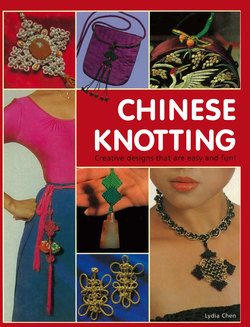Читать книгу Chinese Knotting - Lydia Chen - Страница 9
На сайте Литреса книга снята с продажи.
ОглавлениеINTRODUCTION
The Shuo Wen Chieh Tzu, a Chinese dictionary compiled around 100 A.D., defines the word “knot” as “the joining of two cords.” Archaeological research indicates that such coupling, originally a necessary sewing skill, may have been going on for tens of thousands of years in China. But over the centuries, knots began to take on functions in and of themselves, and were eventually appreciated for their intricate beauty as well. The art form of traditional decorative knotting was thus born.
Unfortunately the silk cords used to tie traditional knots were highly prone to decay. The only complete specimens of traditional Chinese knotting surviving today are works from the late Ching Dynasty and the early Republican period. Despite the age of these pieces, their intricate knotwork and magnificent color combinations are still enough to take one’s breath away.
In those days, decorative knots were tied to wind chimes, palace lanterns, eyeglass cases, fan tassels, hair pins, and a multitude of other objects. They were in effect decorations of decorations, lending elegance and a subtle flavor to objects that would otherwise seem commonplace. The Chinese pursued this ornamentation as a serious art form, and devoted prodigious amounts of time and energy to the perfection of new and more intricate knots. What remains of their work is not only a marvel of technical ingenuity — it is the result of a people’s creative spirit searching for aesthetic expression.
To study the design of Chinese knots is to enter the world of Chinese folk symbols of good fortune. In the pages ahead, you will encounter designs fashioned after symbols of longevity, happiness, Buddhist treasures, prosperity, and the commonality of all being, to name just a few.
On a more personal level, it is impossible to look at one of the old knots without wondering about the life of the knotter. How many hopes and dreams worked their way into the interlaced loops and twists as the single strand of cord wound its way into a complete, perfect figure? The knots are almost a study of life itself.
In China, knotting was not only a fine art, but also a form of communication whereby people could express blessings, best wishes, and amorous sentiments.
Delicately knotted waist cords and sashes adorn these Tang Dynasty statues.
Knotwork decorating the handle of a Ching era jade scepter.
From the bone needles of a hundred thousand years ago to the paintings and statues from imperial China showing traditional flowing robes held shut with knotted sashes, it is clear that knots have long been an integral part of Chinese daily life. Unfortunately, the only complete knotting specimens that survive intact are less than a century old, from an era when knots were used to ornament other works of art — their beauty often unnoticed as they were merely meant to enhance the objects they adorned.
Clockwise from above: decorative knots adorning a woman’s sachet; knotting attached to a bed canopy; a grand ensemble from a Ching woman’s trousseau; and an eyeglass case with ornamental knotting from the Ching Dynasty.
During the late Ching Dynasty and the early Republican period, exquisite knots made of the finest silk cords graced tobacco pouches, eyeglass cases, sachets, and a host of other everyday items, adding a touch of gaiety and enchantment to a way of life which emphasized propriety and sobriety.
The human hand is a miraculous organ, and one would be hard pressed to find better proof of this than in the craftsmanship and ingenuity of Chinese decorative knotting. With nothing more than a simple piece of cord and two sensitive hands, generations of Chinese women have created unsung masterpieces of aesthetic expression.
Knotwork by Cecilia Chen.
Handmade decorations create a special aura of individuality however they are used. Chinese knots can lend a bit of Oriental delicacy to flutes, paintings, lamps, fans, seals, even the latest fashions — subtly enhancing the appeal of anything they grace.
Modeled by Shen Man-kuang.
INSTRUCTIONS FOR TYING THESE KNOTS ARE ON PAGES 98-99
INSTRUCTIONS FOR TYING THESE KNOTS ARE ON PAGES 114-115
Chinese knots are much more than mere eye-catchers; many are ripe with symbolic connotations. Borrowing from a rich trove of traditional decorative motifs, the knots can express wishes for good fortune and wealth, the joys of matrimony, and even the loftiest of religious ideals.
Decorative and imaginative clothes fasteners.
